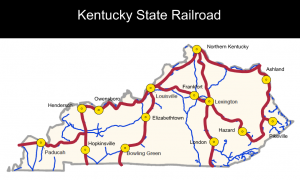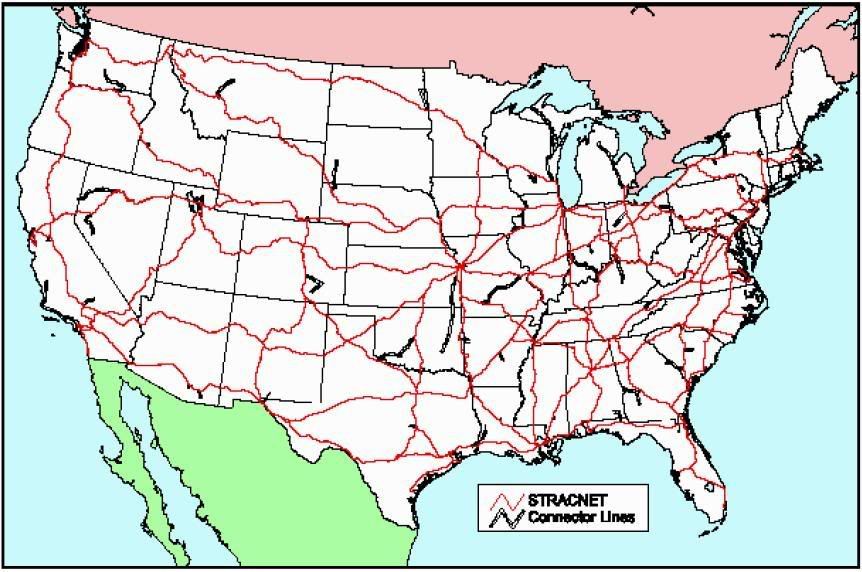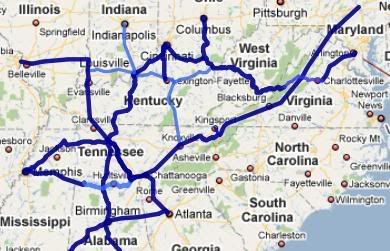(11 am. – promoted by ek hornbeck)
Burning the Midnight Oil for Living Energy Independence
 Doctor Dan Mongiardo, Kentucky’s Lieutenant Governor, has announced that he is running for the Democratic nomination for the Kentucky Senate race, to take on whoever wins the Republican nomination to challenge for the seat that Senator Bunning (R-Big$$$) has announced he is giving up.
Doctor Dan Mongiardo, Kentucky’s Lieutenant Governor, has announced that he is running for the Democratic nomination for the Kentucky Senate race, to take on whoever wins the Republican nomination to challenge for the seat that Senator Bunning (R-Big$$$) has announced he is giving up.
Lots of politics to unwrap in that paragraph, which I’ll leave to the political wise-guys. The Sunday Train today is about Dr. Dan’s Rail Plan.
As far as I can tell, Dr. Dan’s Rail Plan has four main parts, and regular readers of the Sunday Train will recognize much from each of the four parts:
- Support for expanding Kentucky’s existing and potential Amtrak routes into 110mph Emerging Higher Speed Rail corridors
- Support for regional rail services to complete the above state rail map
- “Hybrid Light Rail” to provide cross-metropolitan local rail services, principally to Louisville
- Heavy investment in complementary local transit, including bus rapid transit and a high frequency driverless monotrain system for Kentucky.
Act Blue Page
For those looking to send some snake oil Doctor Dan’s way: Daniel Mongiardo’s Act Blue Page.
Dr. Dan’s Prescription
Dr. Dan lays heavy weight (speech) on the fact that Kentucky gets under 30% of its gas taxes to the Transit Fund back, while getting over 90% of its Highway Fund gas taxes back, so his proposal to fund the bulk of the local transit is basically, “get our Transit Money back”.
What makes this encouraging for those of us outside Kentucky is that he lays part of the blame on the Bush-era Dept. of Transport practice of underfunding the 80:20 Federal match, which he claims discriminates against cities without an established system. And its likely to do, but there was a political shell game in getting there.
The political shell game was to persuade rural and suburban Congressmen that there was little in transit funding “for them”. That discouraged them from voting to fund at reasonable levels. That meant competition among applications was brutal, so matches dropped from 80:20 to sometimes 40% or less Federal, 60% or more local. And that was a game that few rural and suburban counties could play at, without substantial help from their state government.
Dr. Dan also looks at the economic benefits of rail and transit, lays out his plan with lots of maps (which pass by too quickly on the YouTube, so its necessary to hit pause frequently, which interrupts the jazz ensemble backing track). And on this point, I believe he has a very handy frame to put around the dry policy wonk arguments on economic benefits:
Per capita income for counties served by Interstate highways is nearly THREE times that of counties that do not have access to good four-lane highways.
It is obvious that continuing to maintain, improve and expand our existing highway and bridge infrastructure in Kentucky is critical. What may not be obvious to some, however, is my belief that if Kentucky is left out of a federal high speed rail network – a network that is – as I said earlier — in the infancy of its planning stages – I fear the economic consequences to our Commonwealth will be like those communities left out of the Federal Interstate Highway system 53 years ago. We will only fall farther behind in our efforts to expand economic opportunities and increase personal incomes.
The next Senator from Kentucky must be a fierce advocate for Kentucky when it comes to not only highways, bridges, locks and dams but also a fierce advocate for mass public transportation.
Have I Seen This Somewhere Before
For three of the treatments prescribed by Dr. Dan’s Rail Plan, all I can say is, “I resemble that remark!”. I would, however, extend his plan in one important area.
 In his speech, he says regarding the Higher Speed Rail component:
In his speech, he says regarding the Higher Speed Rail component:
The high speed rail grid that I envision would connect northern cities like Minneapolis, Chicago, Indianapolis, Columbus and Cleveland to cities in the south like Memphis, Nashville, Birmingham, New Orleans and Miami, we would connect not only Louisville and Cincinnati into a national high speed rail system … we would connect Lexington and potentially Bowling Green, Elizabethtown and London.
By connecting Washington D.C. to the West Coast in a transcontinental high speed rail line that bisects our nation and a passenger rail connecting our smaller cities in Kentucky with our urban centers – something that I will address in a moment — we could potentially enable the majority of Kentuckians to easily access most major cities around the country.
If by “transcontinental HSR”, we are to understand passenger High Speed Rail corridor, it does not make much sense – since “Higher” Speed Rail is primarily for trips of 100miles to 300miles, and very “High” Speed Rail for trips of 200miles to 500miles.
But if “transcontinental HSR” refers to electrifying one of the main east/west STRACNET corridors and upgrading it to allow 100mph single stack container freight – well, that is a vital national priority, and as a side-benefit that corridor would also effectively permit 110mph tilt-train passenger rail services. So under the definitions the DoT uses, that’s a “transcontinental HSR”.
And with one bridging section added to the existing STRACNET, there really could be a transcontinental corridor that passes through Kentucky:
- From the Shenandoah Valley through Charleston WV, Cincinnati, and Louisville;
- Upgrading the corridor through southern Indiana to Vincennes IN, where it connects to the existing STRACNET again
- West to St. Louis and Kansas City, and from there either:
- West to Colorado, Cheyenne, Salt Lake City, Reno via the northern route, Sacramento and the Bay; or
- Southwest to Amarillo, Albuquerque, Tuscon and the LA Basin
 Of course, as previously discussed in the Appalachian Hub series on the Sunday Train, the Steel Interstate approach also supports Louisville / Nashville. And Dr. Dan proposes (as would I) a link from Lexington to Knoxville which would then connect through Chattanooga to either Atlanta or Birmingham and the existing proposed Gulf and Southeast HSR corridors.
Of course, as previously discussed in the Appalachian Hub series on the Sunday Train, the Steel Interstate approach also supports Louisville / Nashville. And Dr. Dan proposes (as would I) a link from Lexington to Knoxville which would then connect through Chattanooga to either Atlanta or Birmingham and the existing proposed Gulf and Southeast HSR corridors.
The Steel Interstate provides a second solid answer to the question, “what does a Senator have to do with transit?”, since the Steel Interstate is chock full of National Government responsibilities, including Defense, International Trade and, of course, Employment and Economic Stability.
Did You Say Monorail?
I will not go into the full plan – you can get an overview from either the speech or the youtube or both – but I will note the Monorail Question.
There are certain circumstances wherea 55mph Monorail offers a compelling case. If distances are too long for 35mph to be fast enough, short enough so 55mph is fast enough, there are too many obstacles to get a right of way on the ground, and there are places to put the large number of pylons required by the monorail, it could be the answer to that question.
Dr. Dan seems to undermine that case for Monorail in Louisville when he stresses how many rail corridors run through Louisville and how he hopes to be able to gain the cooperation of the Right of Way owners in most or all of them for Hybrid Light Rail. If a Hybrid Light Rail system criss-crosses the city, then either a Bus Rapid Transit, Aerobus, or Rapid Streetcar or mix of two or three might be a better match.
On the other hand – Dr. Dan is running for the Senate. So what is important is how he proposes to go about supporting the monorail. If the support consists of technology neutral preferences for systems that can offer high frequency and can be operated effectively in service of late night shifts, then its up to the city putting together the application to find the approach that is the right fit.
So there is that caveat: as long as the discussion of the driverless Monorail is pointing to the need to support those kind of features in a city like Louisville, where there needs to be support for all shifts, and not just a 9am-5pm office commute … I’d hope that Louisville would do a wide canvass of all technologies to place that role in the integrated system.
Conclusions
Writing on Dr. Dan’s Rail Plan at TheTransportPolitic, Yonah Freemark says:
The candidate’s proposals reflect that he is a novice in matters of transportation, but there’s a larger point here.
What’s most interesting about Mr. Mongiardo’s proposed transit links is that a senator in the U.S. Congress has very little direct influence on the decision-making of local authorities when it comes to transit, nor on the choices made by the state government on intercity rail. Nevertheless, he seems to have concluded that a specific vision of where new transit might go is more palpable to voters than a simple promise of more federal money. Unfortunately, the latter is the one thing a senator actually can produce.
In fact, Mr. Mongiardo makes the very good point that his state contributes around four times as much to the mass transit trust fund as it gets back – the federal government should fund more non-automobile transportation there.
I would disagree on one specific point. U.S. Senators have an unfortunately large amount of influence on the decision-making of local authorities when it comes to transit and the decision-making of state government on intercity rail. Indeed, Yonah Freemark himself made the point about Minneapolis likely choosing a second-best light rail alignment because that’s what “scored well” on the Department of Transport formula.
Getting those formulas so that they deliver better outcomes is a problem local transport planners areas know about, but can’t do anything about. Senators, on the other hand, can do something about it – the enabling legislation that the formula rests on passes through the Senate – but generally see a lot other areas as more exciting things to grandstand on.
Which is one of the biggest reasons that, in this month of bad news for progressives, I find Dr. Dan’s Rail Plan something to get a little bit excited about.

3 comments
Author
My daughter was recently assaulted by her doctor with a drug test. In this fucked up world missed doctor’s appointements equals a substance abuse test. She is 30 weeks pregnant, unemployed and thus can not afford legal expenses to defend herself. This fuckwad wants to cover his ass because they screwed up the circumcision of my first grandchild. Yes, I may be slightly off topic here but there are sort of priorities to the salvation of mankind. This one being the right to determine your own health, or not.
http://vactruth.com/2009/12/19…